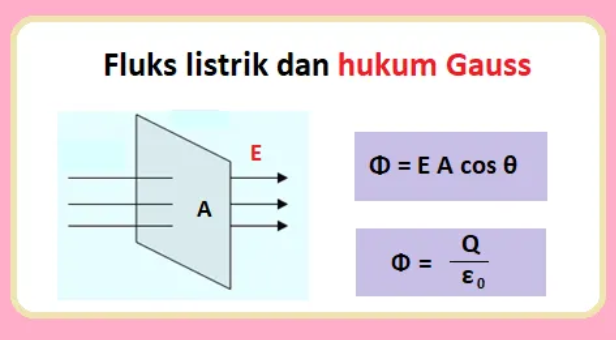Gauss's Law
Gauss's Law – On this occasion Yuksinau.co.id will review the Material about Gauss Law. The discussion this time includes understanding, sound, electric field force lines, formula, electric flux and example problems. For that we simply refer to the full review below.
Table of Contents
Understanding Gauss's Law

In physics, Gauss's Law is a law that connects the distribution of an electric charge with the electric field that will be generated.
Gauss's law was the law invented by a physicist named Carl Friedrich Gauss of the year 1835, Gauss's law belongs to one of Maxwell's equations, some of the laws included in Maxwell's equation are, Faraday's Induction Law, Gauss's Law of Magnetism, as well as the Law of Ampere series. Gauss's own law can be used to derive Coloumb's Law.
Gauss law related to electric flux ,before discussing in more detail about the gauss law let's look at an explanation of electrical flux in order to better understand the gauss law. Electric flux is the product of electric force and the area of the field that is crossed by that area.
If there are lines of force from a homogeneous homogeneous electric field that penetrate an area of area A, the electric flux (Φ) passing through an area depends on the strength of the electric field, area of the area penetrated, and the angle of fall. There are two possibilities, that is, the force falls vertically or the force falls not perpendicularly.
- When style falls straight, can be formulated as follows:
| Φ = E. A |
- When the style falls irregularly, can be formulated as follows:
| Φ = E. A. cos θ |
Information:
Φ = Electric flux (Wb).
E = electric field strength (N/C).
A = The area of the field penetrated by the electric field (m2).
θ = the angle between the normal field line and the incoming force.
Sounds Gauss's Law
Gaussian law has the following sound:
| "The number of lines of force that penetrates a closed surface is directly proportional to the charge”. |
Gauss's Law can be formulated as follows:
| Φ = E. A. cos θ = Q/εThe Q = E. A. cos θ |
Information:
Q = load surrounded by closed surface
ε 0 = air permittivity
Line – Electric Field Force Lines.
The electric field can be represented by imaginary lines whose direction comes out of the positive charge and the direction it enters into the negative charge. The density of the electric lines shows how strong the electric field is.
Electric field force lines that penetrate perpendicular to a rectangular field that has area A. The number of electric field force lines per unit area is directly proportional to the strength of the electric field, so that the sum of the field force lines penetrates a field that has a width A rather than a straight E.A.
FElectric luks
Electric flux is defined as the result of a scalar multiplication between an electric field strong vector and a vector from outside the surface penetrated by the field. Electric flux passing through a surface can be formulated as follows:
| Φ = E.A = EA. cos θ |
With :
A is the surface area
θ is the angle produced between the electric field and the surface area vector.
If the surface is penetrated, the field consists of several segments,then the total flux is equal to the total flux in each segment. Total flux can be formulated as follows :
| Φ = Φ 1+ Φ 2+ Φ 3+ Φ 4+….+ Φ n Φ = E1.A1 + E2.A2 + E3.A3 + E4.A4 +…+ En.An Φ = E1.A1cos θ 1+E2.A2cos θ 2+E3.A3cos θ +E3.A3cos θ +E4.A4cos θ +…+En.Ancos θn |
Where E is the field that penetrates the surface of A.
Sample Questions
Question 1 : When there is a square with a side length 30 cm, and a homogeneous electric field of 400 The N / C is shot into the rectangle in a direction that is perpendicular to the rectangular plane, calculate the amount of electrical flux that penetrates the square plane?
Answer :
known: side length = 30cm
A=30 x 30 =900 cm2 =9 x 10-2 m2
E=400 N/C
Asked : electric flux (Φ)
Answered :
Φ = E.A.
Φ =400.9 x 10-2 m2
Φ =36 Wb
Question 2 : If there is a circle field with fingers 10 cm. and there is an electric field strength (E) with big 300 The N / C leading to that field produces an angle 900 to the field. Calculate the electric flux?
Answer:
Known :
E=300 N/C
Fingers = 10cm
θ = 900 =0
Asked:
electric flux?
Answered:
A= π r2
A= 3,14 x 102
A= 314 cm2 = 3,14 x 10-2
Φ = E. A.cos θ
Φ = 300 x 3,14 x 10-2 x cos 90
Φ = 300 x 3,14 x 10-2 x 0
Φ = 0
Such is the discussion of Gauss's Law. Hope it can be useful for the readers. You can also learn about other Physics Materials that we have provided below.
Other Articles :
- Electromagnetic wave
- Potential Energy Formula
- Conductor and Isolator
- Lenz's Law
The post Hukum Gauss appeared first on YukSinau.co.id.
